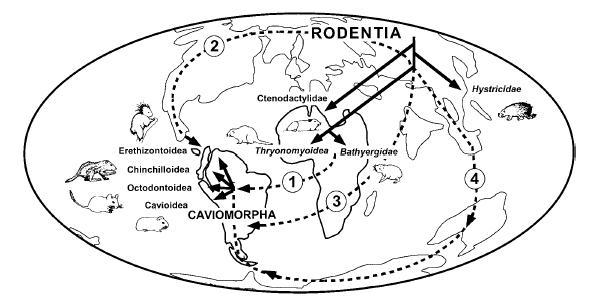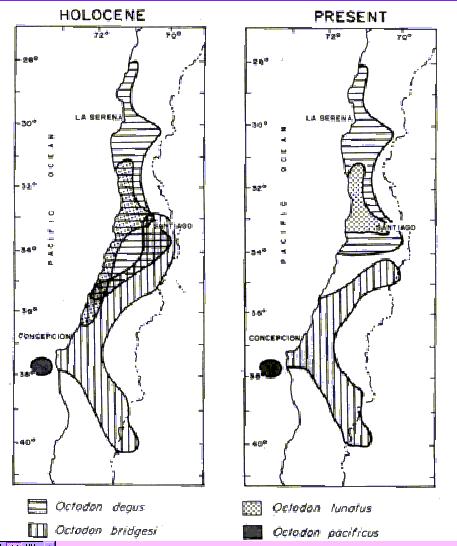Ever wondered how degus evolved or how long they're been around? Probably not, but it's all here!!

South America was an isolated continent during the Tertiary (from the late Eocene to the
Mio-Pliocene)25.
During this time it was inhabited by marsupials, edentates, ungulates, primates and rodents25.
However, to begin with South America did not contain caviomorphs, they appeared in the continent at the
Eocene-Oligocene transition25
(37.5-33.8 million years ago103
, 123).
The emergence of the caviomorph group was sudden and underwent rapid diversification (split into a variety of species)
in the early Oligocene25.
This 'invasion' is thought to have caused the South American extinction of small mammals such as
marsupials25
which were less adaptive to environmental change. The oldest reported octodontid
is Platypittamys brachyodon, from the Deseadan Oligocene of Bolivia and
Patagonia52
, 115,
although this is subject to some debate52
, 125.
The post cranial skeleton of this species is said to be remarkably similar to that of the species Octodon52.
Caviomorphs have been so successful in adapting that they have continued to widely diversify since the
Oligocene to the present day25
, 123.
In fact, of the caviomorphs, Octodontoidea is the most
diversified group25
(and the one that contains the degu), although it is now represented by relatively few species119.
Caviomorphs are a unique group, with early fossils only being identified in South America, Africa
and Eurasia25
, 126,
although octodontid paleoecology is scarce26.
Recent evidence suggests caviomorphs originated singularly in Africa25
, 127
around 40 million years ago44
, 103
(with a basal divergence occurring 59 million years ago103)
and migrated gradually transatlanticaly25
(see figure 1 below). It is thought this was achieved as the two continental plates were rifting, with
temporary land masses allowing organisms to 'hop' between continents120.
This is still subject to speculation120,
with some studies finding evidence for caviomorph origin from Asia126.
Upon arrival of the caviomorphs into South America, there followed a 'cooling period' of 36-25
million years25,
during which time they developed hypsodont (high crowned) teeth25
to cope with the new environment128.
It is suggested that since that period (during mid-late Miocene123)
it took 13-18 million years for modern octodontoids (including degus) to evolve25.
In fact, the rate of divergence/evolution of Octodontidae has been determined at 0.75 % per million
year103,
with a mean divergence of 5.1 million years ago123.
It is suggested that Octodon degus diverged 2.57 million years ago, during the late Pliocene123,
with Octodon lunatus and Octodon bridgesii diverging 0.77 million
years ago, during the mid Pleistocene123.

Figure 1- Illustrating the evolutionary origin and migration/dispersal of caviomorphs.
Source: Huchon, D. and Douzery, E. (2001) 'From the Old World: A molecular chronicle of the phylogeny and biogeography of hystricognath rodents.' Molecular Phylogenetics and Evolution, 20: 238-251. (Ref. 25)
After the evolution of degus into separate species, a visible distribution pattern began to
emerge. The distribution of all the degu species has constantly changed since
the Holocene (see figure 2 below). Bridge's degu disappeared from the Andes due
to habitat clearance for human horticultural development 1,500 years ago26.
Bridges' degu has become extinct in costal regions due to the expansion of local
agriculture just 200 years ago26.
They have also more recently become
extinct in north-central Chile due to human influence26.
Moon-toothed degus are currently confined to central Chile26,
but originally inhabited regions at least 50 km south of their current location26
according to archaeological evidence dated 1,000 years old26.
As figure 2 demonstrates, Bridges' degu, the common degu and the moon-tooth degu
all used to co-habituate, but are currently all allopatric species and no longer
mix freely26.

Figure 2- Showing the distribution of all four degu species in the Holocene and in the present day.
Source: Saavedra, B. and Simonetti, J. (2003) 'Holocene distribution of Octodontid rodents in central Chile.' Revista Chilena de Historia Natural, 76: 383-389. (Ref. 26)
INTERESTING FACT: Did you know that caviomorph genes evolve (on average) around two times as fast as human genes?!79